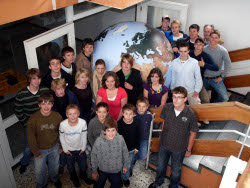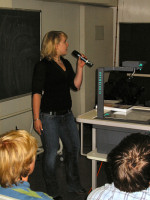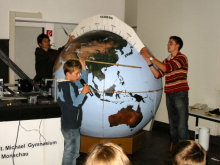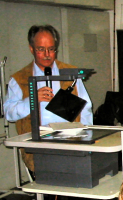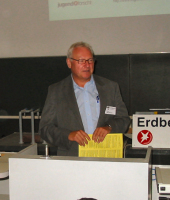Signals from the Earth's Interior - explained to teachers by Young Students
The Seismic-Working-Group of the St.-Michael-Gymnasium (Monschau, Germany) holds a guest lecture at Cologne University.
Monschau/Cologne (Germany). The Seismic-Workgroup of the St.-Michael-Gymnasium Monschau was recently guest at the University of Cologne, not in order to learn, but to demonstrate their aims to teachers on an annual training course. The workgroup was invited by the MNU (German Association for the Advance of Mathematical and Scientific Teaching) of North-Rhine-Westphalia.
Intensive Preparation
Much effort was to be taken for this change in cast, and mathematics teacher Ulrich Arndt, leading the school-workgroup since 1996, got support from the teachers' staff, giving the workgroup students time off to prepare their performance in Cologne. 24 students (form 7 up to form 13) belong to the workgroup.
The lecture was entitled: "Signals from the Earth's Interior - pupils and students present what could be learned by a self-constructed School-Earthquake Station."
Globe in a bottleneck
One week before the lecture, a planning group inspected the location at the university in order to ensure an easy installation of the experimental set. So a twisted way through the basement of the Institute for Chemistry was explored, in order to transport the self-built geophysics globe - 2 meters in diameter - from the outdoor to the lecture room. In addition, a modem access was tested: during the lecture the signals recorded by the seismographs in Monschau should be shown to the audience live.
A day before the performance the globe and all the other technical equipment was - well-cushioned - stowed away on a truck and taken to Cologne. At the Institute for Chemistry reconstructions had meanwhile taken place: so a projecting ledge blocked up the planned way for the globe. By force, tactile sensitiveness and only a few millimeters clearance both hemispheres on edge could be maneuvered through the narrow passage.
With three parents as chauffeurs the team reached Cologne the next day. Some nervousness had crept in, for the audience would consist of teachers and professors. The MNU-President (North-Rhine), Alexandra Dreiseidler, the geophysicist Professor Dr. Tezkan (Univ. of Cologne) as well as a delegate from the seismological observatory at Bensberg (Germany) had come to the lecture.
At any rate, the students of the upper forms could inform the audience on earthquakes as natural disasters, on the origin of quakes and the exploration of the earth�s interior by studying the propagation of earthquake waves. It was shown at the object, how the self-built educational seismograph takes signals und how the school earthquake observatory (Young Researchers 1996 of school, see homepage) works in detail. Live-contacting the seismographs in Monschau per modem succeeded at the first onset. On the large globe the youngsters of the WG simply and vividly could demonstrate, in which way an earthquake could be localized with the seismic school-station.
The workgroup got much applause and received high praise by the MNU-Chairman Dieter Stauder.
Eifeler Nachrichten / Eifeler Zeitung 221 A2, 20.09.2008, S. 22
Thanks to E. Kröttgen for help by translating the German Original.
